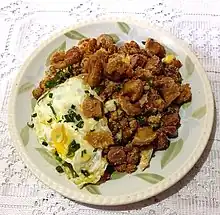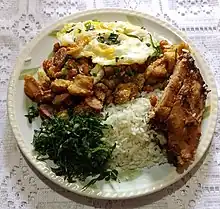
Feijão tropeiro or trooper beans is a Brazilian bean dish typical of the Southeast region, being especially popular in the state of Minas Gerais and considered iconic there. It is made of beans, toasted manioc flour (farinha), and dried meat (usually pork). Usually, feijão tropeiro is served with white rice, fried pork cracklins (torresmo), an egg on the top, and oranges on the side. It is deeply connected to association football and nightlife in the state of Minas Gerais.[1][2]
History
Origins

The dish has its origins in the 17th century. Its name comes from the tropeiros – merchants who sold horses, mules, and food between the south and southeast regions of Brazil.[3][4] As they were always on the backs of horses and mules, they needed a dish that was light and easy to transport with them, so they created feijão tropeiro, which was made initially of beans, manioc flour, and dried meat.[5][6]
The dish is also called feijão-de-preguiça ("lazy beans") and, because it is commonly served for lunch, feijão-das-onze ("eleven o'clock beans").[5]
Evolution
Over time, feijão tropeiro became very popular and evolved. It became a richer dish with the addition of other types of meat such as calabresa sausage, fried pork belly, and bacon. It also included collard greens and a fried egg on top. The dish today is served with white rice, shredded collard greens, corn purée,[5] and a slice of orange on the side.
Cultural importance
Feijão tropeiro is one of the best-known dishes in Brazilian cuisine,[6] which has a great cultural impact around the southeastern states. The dish is iconic in Minas Gerais.[7]
Connection with sports
This cuisine is one of the symbols of football culture in the city of Belo Horizonte. At Mineirão stadium, the dish became a tradition on match days.[8] The dish gained its first popularity in the late 1990s, becoming more popular over the decades with restaurants inside the stadium which started selling and become famous for the dish.[9][10]
References
- ↑ "Feijão tropeiro | Traditional Meat Dish From Minas Gerais". TasteAtlas. Retrieved 2022-12-07.
- ↑ Fajans, Jane (2013-07-18). Brazilian Food: Race, Class and Identity in Regional Cuisines. A&C Black. ISBN 978-0-85785-043-0.
- ↑ Machado Ramos, Jefferson Evandro (22 February 2023). "Tropeiros - quem eram, trabalho, tropeiros no Brasil Colonial". Sua Pesquisa. Retrieved 2022-12-07.
- ↑ "Feijão Tropeiro - A História Do Prato Mais Nômade Do Brasil". Food and Road (in Brazilian Portuguese). 2020-03-10. Retrieved 2023-02-02.
- 1 2 3 Hamilton, Cherie (2005). Brazil: A Culinary Journey. Hippocrene Books. p. 114. ISBN 978-0-7818-1080-7.
- 1 2 Miranda, Beatriz (15 June 2021). "Where a meal without beans is incomplete". BBC Travel. Retrieved 2023-05-07.
- ↑ "Troopers' beans are a star attraction at Mineirão". Anthony Bourdain: Parts Unknown. 2018-04-11. Retrieved 2023-05-26.
- ↑ "Conheça a história do tradicional tropeiro do Mineirão". Globo.com (in Brazilian Portuguese). 5 September 2015. Retrieved 2022-12-07.
- ↑ Young, James (27 June 2014). "Belo Horizonte a delight for food and football". ESPN. Retrieved 2022-12-07.
- ↑ Trigueiro, Karla (2019). "O FEIJÃO TROPEIRO DO MINEIRÃO – ASPECTOS CULTURAIS E A APROPRIAÇÃO SIMBÓLICA DO TERRITÓRIO" (PDF). Encontro da Associação Nacional de Pós-Graduação e Pesquisa Em Geografia. 13.